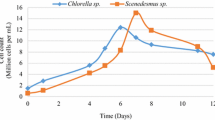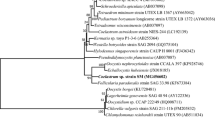Abstract
Wastewater from different sources with excessive nutrient loading, which is a major contributor to eutrophication, can be a promising medium alternative for microalgae cultivation with effective removal of NH4+-N, PO43--P and organic matter. In this study, three groups of synthetic wastewater (SWW), an ammonium-rich stream (60 to 250 mg L-1 NH4+) containing a specific type of organic matter, such as petroleum effluent (SWW1: 300 mg L-1 glucose and 10 mg L-1 phenol), molasses wastewater (SWW2: 600 mg L-1 glucose), and agro-industrial wastewater (SWW3: no organic matters) were used for growing Chlorella sp. and for investigating its potential for nutrient removal as well as the production of biomass and lipid. The findings showed that Chlorella sp. grown in SWW2 (i.e., the auto/mixotrophic culture with 14 days) served as efficient feedstock for lipid production, and showed the maximum lipid content and yield of 53 % DCW and 188 mg L-1, respectively. Additionally, the maximum removal of 76 % NH4+-N was observed under this condition. Higher removal of NH4+-N with 100 % efficiency was seen in Chlorella sp. under SWW1 and SWW3 conditions. However, under SWW2 the cells had higher NH4+ uptake rate than that under SWW1 and SWW3, resulting in highest biomass productivity in SWW2 grown cells. The spent media after Chlorella sp. cultivation were used for growing the N2-fixing cyanobacterium Fischerella muscicola TISTR 8215 for the production of hydrogen. Among different spent media, F. muscicola TISTR 8215 cultivated in SWW1 spent medium obtained from 7-day Chlorella sp. cultivation had the highest hydrogen production of 200.8 µmol H2 mg-1 chlorophyll a. Overall, the present study employed biorefinery approach using the microalga biomass as feedstock for lipid production with subsequent utilization of spent medium for growing the cyanobacterium for enhanced production of hydrogen.





Similar content being viewed by others
Data availability
All data supporting the findings of this study are available within this paper and provided as supplementary information.
References
Abdelfattah A, Ali SS, Ramadan H, El-Aswar EI, Eltawab R, Ho SH, Sun J (2023) Microalgae-based wastewater treatment: Mechanisms, challenges, recent advances, and future prospects. Environ Sci Ecotech 13:100205
Abou-Shanab RA, Matter IA, Kim SN, Oh YK, Choi J, Jeon BH (2011) Characterization and identification of lipid-producing microalgae species isolated from a freshwater lake. Biomass Bioenergy 35:3079–3085
Allahverdiyeva Y, Leino H, Saari L, Fewer DP, Shunmugam S, Sivonen K, Aro EM (2010) Screening for biohydrogen production by cyanobacteria isolated from the Baltic Sea and Finnish lakes. Int J Hydrogen Energy 35:1117–1127
Baebprasert W, Jantaro S, Khetkorn W, Lindblad P, Incharoensakdi A (2011) Increased H2 production in the cyanobacterium Synechocystis sp. strain PCC 6803 by redirecting the electron supply via genetic engineering of the nitrate assimilation pathway. Metab Eng 13:610–616
Baethgen WE, Alley MM (1989) A manual colorimetric procedure for measuring ammonium nitrogen in soil and plant Kjeldahl digests. Commun Soil Sci Plant Anal 20:961–969
Baldisserotto C, Demaria S, Arcidiacono M, Benà E, Giacò P, Marchesini R, Pancaldi S (2023) Enhancing urban wastewater treatment through isolated Chlorella strain-based phytoremediation in centrate stream: An analysis of algae morpho-physiology and nutrients removal efficiency. Plants 12:1027
Cerniglia CE, Gibson DT, Van Baalen C (1979) Algal oxidation of aromatic hydrocarbons: formation of 1-naphthol from naphthalene by Agmenellum quadruplicatum, strain PR-6. Biochem Biophys Res Commun 88:50–58
Chandra R, Rohit MV, Swamy YV, Mohan SV (2014) Regulatory function of organic carbon supplementation on biodiesel production during growth and nutrient stress phases of mixotrophic microalgae cultivation. Bioresour Technol 165:279–287
Chen CY, Kao AL, Tsai ZC, Chow TJ, Chang HY, Zhao XQ, Chang JS (2016) Expression of type 2 diacylglycerol acyltransferse gene DGTT1 from Chlamydomonas reinhardtii enhances lipid production in Scenedesmus obliquus. Biotechnol J 11:336–344
Eungrasamee K, Miao R, Incharoensakdi A, Lindbla P, Jantaro S (2019) Improved lipid production via fatty acid biosynthesis an free fatty acid recycling in engineered Synechocystis sp. PCC 6803. Biotechnol Biofuels 12:8
Feng P, Deng Z, Hu Z, Fan L (2011) Lipid accumulation and growth of Chlorella zofingiensis in flat plate photobioreactors outdoors. Bioresour Technol 102:10577–10584
Gorman DS, Levine RP (1965) Cytochrome f and plastocyanin – their sequence in photosynthetic electron transport chain of Chlamydomonas reinhardi. Proc Natl Acad Sci USA 54:1665–1669
Guldhe A, Ansari FA, Singh P, Bux F (2017) Heterotrophic cultivation of microalgae using aquaculture wastewater: a biorefinery concept for biomass production and nutrient remediation. Ecol Eng 99:47–53
Jia B, Song Y, Wu M, Lin B, Xiao K, Hu Z, Huang Y (2016) Characterization of long-chain acyl-CoA synthetases which stimulate secretion of fatty acids in green algae Chlamydomonas reinhardtii. Biotechnol Biofuels 9:184
Kaushik A, Mona S, Kaushik CP (2011) Integrating photobiological hydrogen production with dye–metal bioremoval from simulated textile wastewater. Bioresour Technol 102:9957–9964
Khan SA, Sharma GK, Malla FA, Kumar A, Gupta N (2019) Microalgae based biofertilizers: a biorefinery approach to phycoremediate wastewater and harvest biodiesel and manure. J Clean Prod 211:1412–1419
Khetkorn W, Lindblad P, Incharoensakdi A (2010) Enhanced biohydrogen production by the N2-fixing cyanobacterium Anabaena siamensis strain TISTR 8012. Int J Hydrogen Energy 35:12767–12776
Li Y, Zhou W, Hu B, Min M, Chen P, Ruan RR (2011) Integration of algae cultivation as biodiesel production feedstock with municipal wastewater treatment: strains screening and significance evaluation of environmental factors. Bioresour Technol 102:10861–10867
Li YR, Tsai WT, Hsu YC, Xie MZ, Chen JJ (2014) Comparison of autotrophic and mixotrophic cultivation of green microalgal for biodiesel production. Energy Procedia 52:371–376
Liu M, Zhao Y, Xi B, Hou LA, Xia X (2014) Performance of a hybrid anaerobic-contact oxidation biofilm baffled reactor for the treatment of decentralized molasses wastewater. Front Environ Sci Eng 8:598–606
Liu X, Wei L, Zhang J, Zhu K, Zhang H, Hua G, Cheng H (2021) Effects of sulfate ions on growth and lipid synthesis of Scenedesmus obliquus in synthetic wastewater with various carbon-to-nitrogen ratios altered by different ammonium and nitrate additions. Bioresour Technol 341:125766
Miao X, Wu Q (2004) High yield bio-oil production from fast pyrolysis by metabolic controlling of Chlorella protothecoides. J Biotechnol 110:85–93
Miller GL (1959) Use of dinitrosalicylic acid reagent for determination of reducing sugar. Anal Chem 31:426–428
Nagarajan D, Lee DJ, Varjani S, Lam SS, Allakhverdiev SI, Chang JS (2022) Microalgae-based wastewater treatment–microalgae-bacteria consortia, multi-omics approaches and algal stress response. Sci Total Environ 845:157110
Peng YY, Gao F, Hang WJW, Yang HL, Jin WH, Li C (2019) Effects of organic matters in domestic wastewater on lipid/carbohydrate production and nutrient removal of Chlorella vulgaris cultivated under mixotrophic growth conditions. J Chem Technol Biotechnol 94:3578–3584
Pillay B, Pillay I, Obwaka EM, Mohammadi AH (2016) Production of synthetic wastewater in laboratory scale. In: Daniels JA (ed) Advances in Environment Research. Nova Science Publishers, NY, pp 77–100
Priyadharshini SD, Babu PS, Manikandan S, Subbaiya R, Govarthanan M, Karmegam N (2021) Phycoremediation of wastewater for pollutant removal: a green approach to environmental protection and long-term remediation. Environ Pollut 290:117989
Ren HY, Song X, Kong F, Song Q, Ren NQ, Liu BF (2023) Lipid production characteristics of a newly isolated microalga Asterarcys quadricellulare R-56 as biodiesel feedstock. Environ Sci Pollut Res Int 30:48339–48350
Rice EW, Baird RB, Eaton AD (eds) (2012) Standard Methods for the Examination of Water and Wastewater, 23rd edn. American Public Health Association, Washington, DC
Rippka R, Deruelles J, Waterbury JB, Herdman M, Stanier RY (1979) Generic assignments, strain histories and properties of pure cultures of cyanobacteria. J Gen Microbiol 111:1–61
Schlee J, Komor E (1986) Ammonium uptake by Chlorella. Planta 168:232–238
Sharma J, Kumar SS, Bishnoi NR, Pugazhendhi A (2018) Enhancement of lipid production from algal biomass through various growth parameters. J Mol Liq 269:712–720
Sivaramakrishnan R, Incharoensakdi A (2017) Enhancement of total lipid yield by nitrogen, carbon, and iron supplementation in isolated microalgae. J Phycol 53:855–868
Song X, Liu BF, Kong F, Song Q, Ren NQ, Ren HY (2023) Lipid accumulation by a novel microalga Parachlorella kessleri R-3 with wide pH tolerance for promising biodiesel production. Algal Res 69:102925
Song X, Kong F, Liu BF, Song Q, Ren NQ, Ren HY (2024) Combined transcriptomic and metabolomic analyses of temperature response of microalgae using waste activated sludge extracts for promising biodiesel production. Water Res 251:121120
Sukrachan T, Incharoensakdi A (2020) Enhanced hydrogen production by Nostoc sp. CU2561 immobilized in a novel agar bead. J Appl Phycol 32:1103–1115
Taikhao S, Junyapoon S, Incharoensakdi A, Phunpruch S (2013) Factors affecting biohydrogen production by unicellular halotolerant cyanobacterium Aphanothece halophytica. J Appl Phycol 25:575–585
Tak BY, Tak BS, Kim YJ, Park YJ, Yoon YH, Min GH (2015) Optimization of color and COD removal from livestock wastewater by electrocoagulation process: application of Box-Behnken design (BBD). J Ind Eng Chem 28:307–315
Ummalyma SB, Sirohi R, Udayan A, Yadav P, Raj A, Sim SJ, Pandey A (2022) Sustainable microalgal biomass production in food industry wastewater for low-cost biorefinery products: a review. Phytochem Rev 13:1–23
Wang H, Xiong H, Hui Z, Zeng X (2012) Mixotrophic cultivation of Chlorella pyrenoidosa with diluted primary piggery wastewater to produce lipids. Bioresour Technol 104:215–220
Wang J, Zhou W, Yang H, Ruan R (2016) Application of nitrogen sufficiency conversion strategy for microalgae-based ammonium-rich wastewater treatment. Environ Technol 37:2638–2648
Wutthithien P, Incharoensakdi A (2022) Improved biohydrogen production by co-cultivation of N2-fixing cyanobacterium Fischerella muscicola TISTR 8215 and microalga Chlorella sp. J Appl Phycol 34:1921–1930
Wutthithien P, Lindblad P, Incharoensakdi A (2019) Improvement of photobiological hydrogen production by suspended and immobilized cells of the N2-fixing cyanobacterium Fischerella muscicola TISTR 8215. J Appl Phycol 31:3527–3536
Yang L, Chen J, Qin S, Zeng M, Jiang Y, Hu L, Wang J (2018) Growth and lipid accumulation by different nutrients in the microalga Chlamydomonas reinhardtii. Biotechnol Biofuels 11:1–12
Yodsang P, Raksajit W, Aro E, Mäenpää P, Incharoensakdi A (2018) Factors affecting photobiological hydrogen production in five filamentous cyanobacteria from Thailand. Photosynthetica 56:334–341
Yu H, Kim J, Lee C (2019) Nutrient removal and microalgal biomass production from different anaerobic digestion effluents with Chlorella species. Sci Rep 9:6123
Zhang TY, Wu YH, Zhu SF, Li FM, Hu HY (2013) Isolation and heterotrophic cultivation of mixotrophic microalgae strains for domestic wastewater treatment and lipid production under dark condition. Bioresour Technol 149:586–589
Acknowledgments
This work was supported by Ratchadapiseksomphot Endowment Fund for Postdoctoral Fellowship from the Graduate School, Chulalongkorn University to PW.
Funding
Financial support was provided by Chulalongkorn University on the Frontier Research Energy Cluster (CU-59-048-EN).
Author information
Authors and Affiliations
Contributions
Palaya Wutthithien and Aran Incharoensakdi conceived the idea, PW conducted experiments, collected and analyzed the data including preparation of the first draft of manuscript. Both authors contributed to manuscript revision and approved the final version of the manuscript.
Corresponding author
Ethics declarations
Competing interests
The authors declare no competing interests.
Additional information
Publisher's Note
Springer Nature remains neutral with regard to jurisdictional claims in published maps and institutional affiliations.
Supplementary Information
Below is the link to the electronic supplementary material.
Rights and permissions
Springer Nature or its licensor (e.g. a society or other partner) holds exclusive rights to this article under a publishing agreement with the author(s) or other rightsholder(s); author self-archiving of the accepted manuscript version of this article is solely governed by the terms of such publishing agreement and applicable law.
About this article
Cite this article
Wutthithien, P., Incharoensakdi, A. Nutrients removal from wastewater by microalga Chlorella sp. coupled to augmented lipid production with spent wastewater utilized by cyanobacterium Fischerella muscicola TISTR 8215 for hydrogen production. J Appl Phycol (2024). https://doi.org/10.1007/s10811-024-03265-3
Received:
Revised:
Accepted:
Published:
DOI: https://doi.org/10.1007/s10811-024-03265-3




